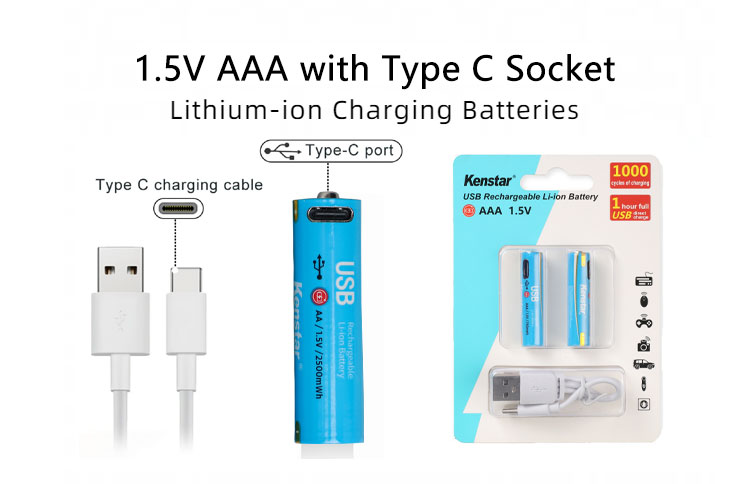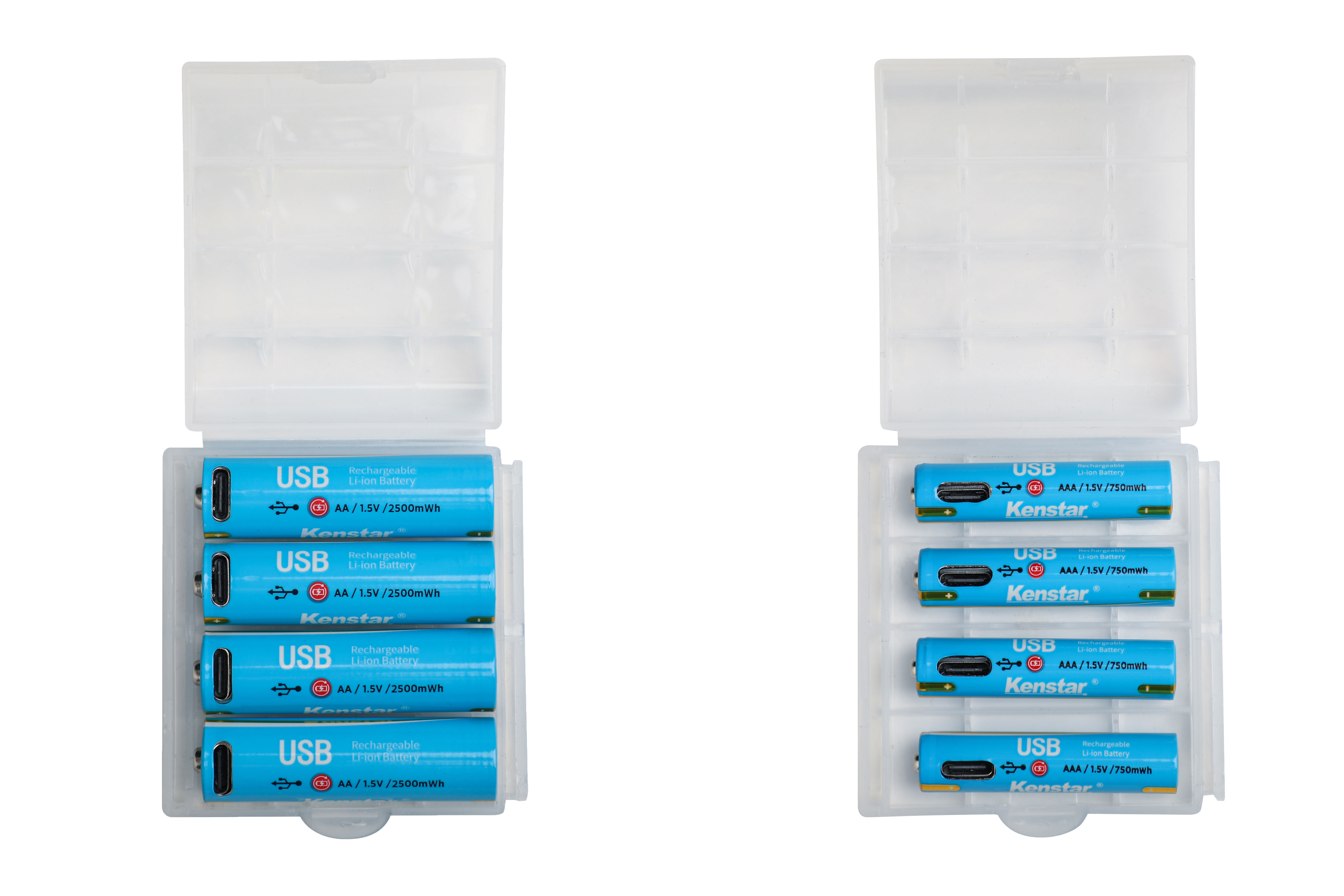
When I use USB-C rechargeable 1.5V cells, I notice their voltage stays steady from start to finish. Devices get reliable power, and I see longer runtimes, especially in high-drain gadgets. Measuring energy in mWh gives me a true picture of battery strength.
Key point: Stable voltage and accurate energy measurement help tough gadgets work longer.
Key Takeaways
- USB-C cells provide stable voltage, ensuring devices receive consistent power for longer runtimes.
- mWh ratings offer a true measure of battery energy, making it easier to compare different battery types.
- USB-C cells manage heat effectively, allowing high-drain devices to run longer and safer.
USB-C Battery Ratings: Why mWh Matters
Understanding mWh vs. mAh
When I compare batteries, I notice two common ratings: mWh and mAh. These numbers look similar, but they tell me different things about battery performance. mAh stands for milliampere-hours and shows how much electric charge a battery can hold. mWh stands for milliwatt-hours and measures the total energy a battery can deliver.
I find that mWh gives me a clearer picture of what my USB-C rechargeable cells can do. This rating combines both the battery’s capacity and its voltage. When I use USB-C cells, I see that their mWh rating reflects the real energy available for my devices. In contrast, NiMH cells only show mAh, which can be misleading if the voltage drops during use.
- The mWh rating of USB-C rechargeable cells accounts for both capacity and voltage, providing a complete measure of energy potential.
- The mAh rating of NiMH cells only reflects the electrical charge capacity, which can be misleading when comparing batteries with different voltage profiles.
- Using mWh allows for more accurate comparisons of energy delivery across various battery types, including those with different chemistries.
I always check the mWh rating when I want to know how long my gadgets will run. This helps me choose the best battery for my needs.
Key point: mWh ratings give me a true measure of battery energy, making it easier to compare different types.
Stable Voltage and Accurate Energy Measurement
I rely on USB-C cells because they keep their voltage steady from start to finish. This stable voltage means my devices get consistent power, which helps them work better and last longer. When I use batteries with fluctuating voltage, like NiMH, my gadgets sometimes shut down early or lose performance.
Industry standards show that different battery types have unique voltage levels. For example, a 2600mAh Li-Ion cell translates to 9.36Wh, while a 2000mAh NiMH cell is only 2.4Wh. This difference shows why mWh is a better way to measure battery energy. I notice that manufacturers use different methods to rate mAh, which can cause confusion. The relationship between mAh and mWh changes depending on the battery chemistry and voltage.
- Different battery chemistries have specific nominal voltages, which affect how capacity is calculated in mAh and mWh.
- There is no universal standard for mAh ratings; manufacturers may use different methods, leading to inconsistencies in published ratings.
- The relationship between mAh and mWh can vary significantly depending on the battery type, especially when moving away from constant voltage sources like NiMH or NiCd batteries.
I trust mWh ratings for USB-C cells because they match the real-world performance I see in my gadgets. This helps me avoid surprises and keeps my devices running smoothly.
Key point: Stable voltage and mWh ratings help me choose batteries that deliver reliable, long-lasting power.
USB-C Technology in High-Drain Devices
.jpg)
How Voltage Regulation Works
When I use tough gadgets, I want batteries that deliver steady power. USB-C cells use advanced voltage regulation to keep devices running smoothly. I see several technical features that make this possible. These features work together to control voltage and current, even when my device needs a lot of energy.
| Feature | Description |
|---|---|
| Power Delivery Negotiation | Devices talk to each other to set the right power level, so voltage stays steady. |
| E-Marker Chips | These chips show if the battery can handle higher voltages and currents, keeping things safe. |
| Flexible Power Data Objects (PDOs) | Batteries adjust voltage for different devices, making sure each gets the power it needs. |
| Combined VBUS Pins | Multiple pins share the current, which keeps the battery cool and efficient. |
| Temperature Rise Tests | Batteries pass safety tests to control heat and prevent damage during heavy use. |
I trust USB-C cells because they use these features to keep my gadgets safe and working well.
Key point: Advanced voltage regulation in USB-C cells keeps devices safe and delivers steady power.
Performance Under Heavy Load
I often use gadgets that need a lot of power, like cameras and flashlights. When these devices run for a long time, batteries can get hot. USB-C cells handle this challenge by controlling voltage and current in small steps. For example, output voltage adjusts in 20mV steps, and current changes in 50mA steps. This keeps the battery from overheating and helps my device perform better.
- The USB-C Power Delivery standard is now common in many industries.
- Compact and reliable USB-C adapters are popular because they support high-wattage devices.
I notice that USB-C cells keep their voltage steady, even when my device draws a lot of power. This means my gadgets work longer and stay safe.
Key point: USB-C cells manage heat and deliver steady power, so high-drain devices run longer and safer.
USB-C vs. NiMH: Real-World Performance

Voltage Drop and Runtime Comparison
When I test batteries in my gadgets, I always look at how the voltage drops over time. This tells me how long my device will work before the battery runs out. I notice that NiMH cells start strong but then drop off quickly after reaching about 1.2 volts. My devices sometimes shut down sooner than I expect because of this steep decline. On the other hand, USB-C cells show a much steadier voltage drop. They start at a higher voltage and keep it stable for longer, which means my gadgets run at full power until the battery is almost empty.
Here is a table that shows the difference:
| Battery Type | Voltage Drop Profile | Key Characteristics |
|---|---|---|
| NiMH | Steep decline after 1.2V | Less stable under high-drain conditions |
| Lithium (USB-C) | Steady descent from 3.7V | More consistent performance in devices |
This steady voltage from USB-C cells helps my high-drain gadgets, like cameras and flashlights, work longer and more reliably.
Key point: USB-C cells keep voltage steady, so my devices run longer and perform better.
Examples in Cameras, Flashlights, and Toys
I use batteries in many tough gadgets, such as cameras, flashlights, and toys. In my camera, I see that NiMH batteries lose power quickly, especially when I take lots of photos or use the flash. My flashlight dims fast with NiMH cells, but with USB-C cells, the light stays bright until the very end. My kids’ toys also run longer and work better with USB-C cells.
I have noticed some common problems with NiMH batteries in these devices:
| Failure Mode | Description |
|---|---|
| Loss of capacity | Battery cannot hold a charge for long |
| High self-discharge | Battery drains quickly, even when not used |
| High internal resistance | Battery gets hot during use |
USB-C cells solve these problems by using built-in protection circuits and advanced safety features. These features keep my gadgets safe and make sure they work well, even when I use them a lot.
| Feature | Description |
|---|---|
| Built-in Protection Circuitry | Prevents overcharging, over-discharging, and short circuits |
| Multi-layered Safety System | Protects against overheating and keeps devices safe |
| USB-C Charging Port | Makes charging easy and convenient |
Key point: USB-C cells help my cameras, flashlights, and toys work longer and safer, with fewer problems.
Practical Benefits for Gadget Users
When I choose rechargeable batteries, I think about cost, safety, and performance. I know that rechargeable batteries cost more at first, but I save money over time because I do not need to buy new ones often. After just a few recharges, I see real savings, especially in devices I use every day.
- Rechargeable batteries save money in high-use gadgets.
- I avoid frequent replacement costs, which adds up over time.
- The break-even point comes quickly, especially if I use my gadgets a lot.
I also look at warranties. Some USB-C rechargeable batteries come with a limited lifetime warranty, which gives me peace of mind. NiMH batteries usually have a 12-month warranty. This difference shows me that USB-C cells are built to last.
I use my gadgets in different places, sometimes in hot or cold weather. I notice that NiMH batteries do not work well in high heat, but USB-C cells keep working, even when it gets hot. This makes them a better choice for outdoor use or tough environments.
Key point: USB-C cells save me money, offer better warranties, and work well in tough conditions, making them a smart choice for my gadgets.
I choose USB-C rechargeable 1.5V cells for my toughest gadgets because they deliver steady, regulated power and precise mWh ratings. My devices run longer and perform better, especially under heavy use. I experience fewer battery changes and more reliable performance.
Key point: Consistent voltage and accurate energy ratings keep my gadgets running strong.
FAQ
How do I charge USB-C rechargeable 1.5V cells?
I plug the cell into any standard USB-C charger. Charging starts automatically. I watch the indicator light for charging status.
Key point: USB-C charging is simple and universal.
Can USB-C cells replace NiMH batteries in all devices?
I use USB-C cells in most gadgets that need 1.5V AA or AAA batteries. I check device compatibility before switching.
| Device Type | USB-C Cell Use |
|---|---|
| Cameras | ✅ |
| Flashlights | ✅ |
| Toys | ✅ |
Key point: USB-C cells work in many devices, but I always confirm compatibility.
Are USB-C rechargeable cells safe for daily use?
I trust USB-C cells because they have built-in protection circuits. These features prevent overheating and overcharging.
Key point: USB-C cells offer reliable safety for everyday use.
Post time: Sep-01-2025




